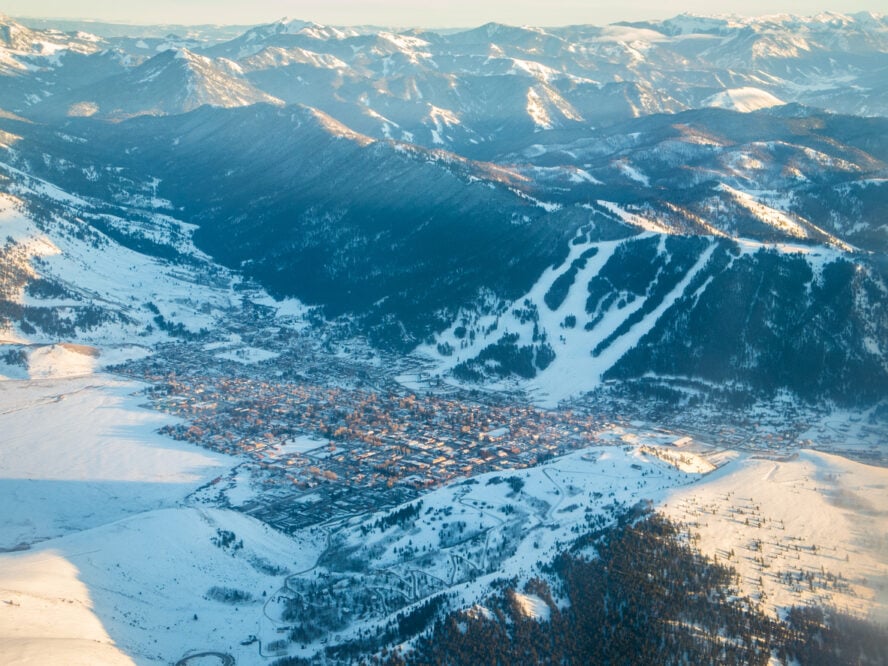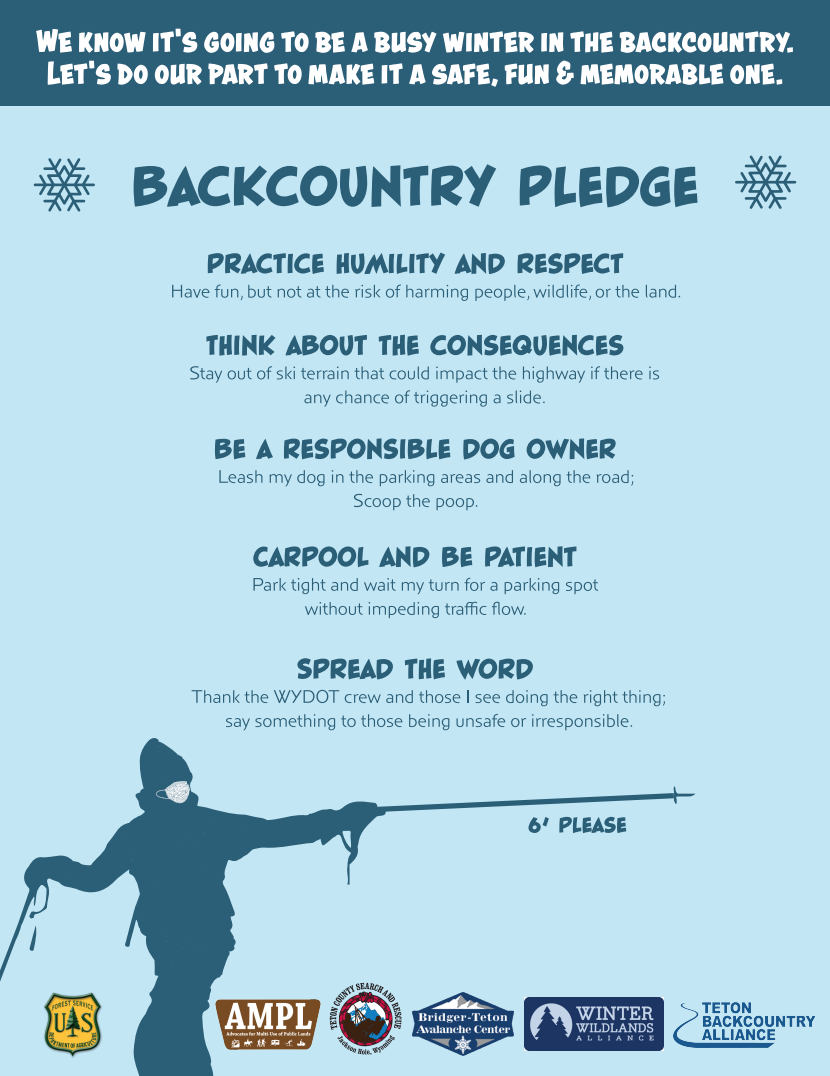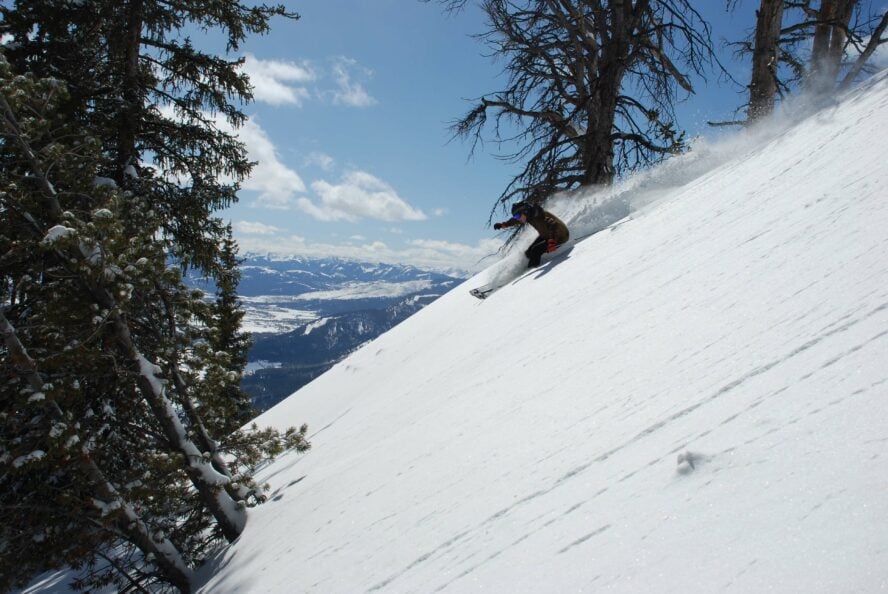The “golden days” of crowd-free slopes have been gone for a while.
Whether it’s a dawn patrol Glory lap or a long tour in Grand Teton National Park, chasing the endless backcountry skiing in Jackson Hole is a near-daily routine for the folks who’ve carved out a life here—as well as the tens of thousands of visitors who make the pilgrimage to these iconic slopes.
These days, however, popular backcountry areas are starting to look more like resort mogul fields. Any time there’s fresh snow it’s a mad dash to the trailhead, and we’re all guilty of getting a little ahead of ourselves when there’s turns on the line. But as trails get backed up like lift lines and classic runs are tracked out before 9 a.m., it’s important to take a step back and figure out how to recreate responsibly on the public lands we are seemingly loving to death.
While it’s easy to reminisce about quieter times of Teton skiing (admittedly, way before I got here)—or gripe about the present—it’s far more productive to figure out how to work together to coexist in the backcountry, as both locals and visitors, so we can all enjoy the pow safely and respectfully.

Jackson Hole a World Class Skiing Destination…
Like many before me, I arrived in the Tetons enthralled by the easy-access powder turns and classic ski objectives. There’s an allure to the jagged skyline not many other ranges can compete with—massive vertical relief, notoriously high annual snowfall totals, steep, iconic lines and challenging ski mountaineering objectives entice skiers from around the globe.
But you don’t have to seek out the gnar to appreciate this extraordinary corner of Wyoming. A lifetime of wide open tree skiing with long sustained fall lines, playful meadows, and roadside access makes it easy for skiers of all ability levels to find their place on the skintrack—and it’s a great place to learn if you’re just getting started in backcountry skiing. Not to mention, it feels like you’re living inside a postcard from almost every angle.
The Tetons have been part of the backcountry conscience for a while: some of the world’s most notorious skiers have cut their teeth on the steep, rugged terrain that Jackson has to offer. Folks like Bill Briggs, Doug Coombs, and Kit DesLauriers have laid the groundwork for those who are pushing the limits of the sport today.
With Teton Pass, Grand Teton National Park, and Jackson Hole Mountain Resort—including some of the best backcountry skiing around Jackson Hole—all less than 30 minutes from downtown, it’s hard to beat if you’re trying to spend as much time as possible on snow. Hence the popularity.

…With growing visitation to boot
For perspective, we have a population of about 24,000 in this valley, and between 2 to 2.5 million visitors annually. While many of those come for the national park in the summer, that’s still a lot of ski bags hitting the luggage belt at the Jackson Hole Airport. It may feel like a vacation, but it’s also a place where many people call home, and visiting any ski destination has an impact.
I’ve been on both sides of the equation: living here for just five years—and visiting many times before—I’m part of the influx in this beautiful range.
If we’re going to tout the incredible ski terrain the Tetons have to offer, it’s part of our collective responsibility to also talk about how to tread lightly and respect the mountainous places we live or are visiting.
Working Together to Protect Access
Threats to access due to skier-triggered avalanches on Teton Pass, parking congestion, foot traffic on the highway, and dog management have prompted initiatives to help address the increase in recreationalists. That’s what led to the creation of the Teton Backcountry Alliance (TBCA), which was founded by a group of local skiers in 2017. Their aim is to promote safety, education, and conservation in order to preserve access to backcountry skiing in the Tetons.
In addition to a team of over a dozen volunteer ambassadors, TBCA collaborates with local agencies like the Bridger-Teton National Forest (BTNF) and the Wyoming Department of Transportation (WYDOT) to share best practices and develop etiquette solutions to keep everyone safer.
Sometimes “common knowledge” is in fact, commonly inaccurate, or shifts in community behavior lead to better and safer outcomes for everyone. A few examples of why this work is important:
-
- Some may be surprised to learn that the pull out where most skiers park on top of the Pass isn’t an official parking lot, and the department of transportation could stop plowing it if skier traffic becomes unmanageable.
- Skinning back up the snowbank after skiing from Mount Glory, instead of walking on the highway, protects skiers from oncoming traffic and snow plows (which mow right through the shoulder and have a hard time stopping).
There’s a lot that goes into skiing responsibly in the Tetons, so I chatted with Gary Kofinas from the Teton Backcountry Alliance and Kailey Mckenna from Jackson Hole Mountain Guides to put together some etiquette tips for skiing in the Tetons.
(Of course, this is on top of being properly educated, knowing how to manage risk in the backcountry, and always carrying the proper equipment, which is baseline).

Tip 1: Be Mindful of Crowded Trailheads and Limited Parking
It’s not uncommon to show up on top of Teton Pass to a queue of cars idling in line for a spot. Add in commuter traffic between Jackson and Teton Valley and you’ve got quite the crowd by 7 a.m. each morning.
“The summit of Teton Pass is a world class destination,” says Kofinas. “But oftentimes the parking is at capacity, and you have to be patient and ‘take a number.’”
What you should do:
If there’s new snow and you’re headed up at a popular time (all day on weekends, 7 a.m. weekday dawn patrols and noon lunch laps) be ready to wait a few minutes or consider parking at another trailhead like Phillips Bench, Coal Creek, or Old Pass Road. Carpool whenever possible (the Stilson Parking Lot in Wilson, also known as the Village Road Transit Center, is a great place to leave a car. Best of all, it’s free), and park tightly once you do get a spot.
If you pull up and there’s already a handful of cars waiting, respect the line order. Often the volunteer TBCA ambassadors will help direct traffic, but it’s also a good idea to have a passenger in your car hop out and chat with other cars waiting.

Tip 2: Utilize Local Resources
Before visiting a new zone, I like to start following the weather and daily avalanche forecast the weeks before I get there.
As an intermountain snowpack, the Tetons generally hold deeper snow and on average more stable conditions than neighboring continental regions like the Colorado Rockies. However, we still deal with lingering persistent weak layers throughout the winter and high amounts of wind are always something to take into consideration. At mid-and-high elevations, wind slabs avalanches are common.
Luckily, the Tetons have tons of great resources for trip planning, before and during your trip, such as our local avalanche bulletin and community events.
What you should do:
The Bridger-Teton Avalanche Center posts daily avalanche forecasts, and shares links to useful weather resources and observations from both forecasters and the public. If you want to go deeper, the State of the Snowpack takes place every other Wednesday at Headwall Sports, a free discussion led by forecaster Mike Rheam to paint a picture of what’s going on out there. Guidebooks like Tom Turiano’s Teton Pass Backcountry Guide or Jackson Hole Backcountry Skier’s Guide: South are excellent resources for the area.
Download the Backcountry Zero app on your phone before you head out, which will streamline your connection to local rescue resources should you get into trouble and need to call for help.
Tip 3: Be Aware of What (and Who) is Below You
There are lots of ski runs, especially on Teton Pass, that can impact the highway if they slide. Popular (and oh so enticing) runs like Glory Bowl and Twin Slides are major offenders, and there are a handful of other slide paths on Teton Pass to keep an eye out for. With up to 400 people on the Pass on some days, it’s also hard to be sure that you’re not dropping in on top of someone.
“There’s definitely been a really good culture shift,” says Kofinas. “On higher risk days we’re seeing people (for the most part) stay out of zones that can affect cars and skiers below. We’ve been lucky so far, and we’re really hoping to continue that.”
There have been incidents in year’s past where skier-triggered avalanches have hit cars on the road. Thankfully there haven’t been any fatalities. Again, one of the main goals of the Teton Backcountry Alliance is to promote good stewardship so that skiers don’t lose access to skiing on the Pass—and we all play a part in this.
What you should do:
Kailey Mckenna, a guide and avalanche educator at Jackson Hole Mountain Guide, adds that communication is key to not skiing on top of each other. “Talk to other parties, even if you’re not in really big terrain it can still be stressful if you don’t know who’s dropping first,” she says. “Communication is huge, both within your group and with other parties.”
If you’re heading for a bigger objective in Grand Teton National Park, do your research on the ski line and know that the culture for skiing many of the classic descents is a top-down approach. Avoid booting up popular lines that might have skiers coming in from above, and communicate with other parties at the trailhead so you can get a sense of where other skiers will be.
Sharing is crucial in crowded places like the Tetons. If you arrive at a ski line and see others already there, have a backup plan. For short lines, waiting it out can be an option, or creating a plan B or C when planning your route to keep your options open and avoid getting into trouble.
Last season, there was an accident in the Silver Couloir on Nez Perce where a solo snowboarder passed a group already climbing the couloir, dropped in on top of them and triggered an avalanche that seriously injured one member of the party. Communication or yielding to the skiers already in the line could have prevented anyone from getting hurt.

Tip 4: Know the Rules about Dogs
Some days it feels like there are more dogs than people on Teton Pass. While skiing with your dog is allowed on Teton Pass, be sure to have your dog on leash in the parking lot (or risk a $200 fine) and don’t forget to scoop the poop!
If you’re skiing with your dog, be mindful not only of the terrain you’re skiing in, but what you’re next to. I’ve been out on the Pass and seen quite a few dogs wander over to steeper slopes and dangerous rollovers, even while their owner and rest of the party is steering clear of avalanche terrain. If you’re skiing more consequential terrain or heading out on a potentially crowded day, consider leaving the dog at home.
What you should do:
If you do choose to bring your dog, keep it on leash in the parking lot and near the trailhead, and have it under voice control elsewhere. Keep your terrain choice mellow and be respectful of other skiers who might be nervous around dogs.
Tip 5: Get to Know Wildlife Closures and Guidelines
In an effort to protect wildlife in the Tetons, there are a number of seasonal closures aimed at protecting animals from unintended disturbance, which can be harmful in their fragile winter state.
Voluntary closures for an endangered herd of bighorn sheep were rolled out in 2022, primarily in Grand Teton National Park as well as some in Bridger-Teton National Forest. Most popular areas aren’t affected, but if you’re someone trying to go deep into the range, definitely be aware of where you’re planning to go. Local skiers are working hard to abide by the most recent closures so as to avoid further closures down the road.
Seasonal winter closures for elk and mule deer aren’t new, and rarely overlap with backcountry ski terrain, but it’s good to get familiar with all closures before you head out.
What you should do:
“If you do see wildlife, maybe a moose while skiing down Old Pass Road, give animals time and space,” says Kofinas. “Especially in the winter, their energy balance is quite fragile and we don’t want them to expend extra energy. Stop and wait, don’t try to run them off.”

Tip 6: Hire a Guide
Local ski guides know the ins and outs of the Tetons better than anyone else in this valley. If you want to make the most of your experience in Jackson, there’s no better way to see the Tetons through the eyes of a local.
While some folks are concerned about overcrowding from guided groups, guide operations in the Tetons all have different permits that keeps their use spread out throughout the range. Some guiding companies, like Teton Backcountry Guides, have more permits for Teton Pass, while operations like Jackson Hole Mountain Guides and Exum are able to operate more in Grand Teton National Park.
Each operation is different in their allotment of user days on different public lands, keeping skiers dispersed throughout the range. As a recreational skier, I’ve never had a problem with guided parties tracking up the zones I want to ski in. In fact, hiring a guide during your trip is a great way to support local businesses and members from the community. A win-win for everyone.
What you should do:
Going on a guided backcountry skiing tour in Jackson Hole is a great way to take some of the hassle out of trip planning and make the most out of your time. Even if you’re not someone who typically skis with a guide, when you’re in a new zone, hiring a guide for at least a day can help you get your bearings and learn quite a bit if you want to.
“You don’t have to hire a guide just to have a good time, although we’ll definitely do that,” adds Mckenna. “If you have specific topics you want to learn about, like navigation or setting skintracks, we can go out and work on that too during a guided day.”
Preserving a Backcountry Experience for Years to Come
“I’m really pleased that people are taking the need to be good stewards seriously, and I hope that continues,” adds Kofinas.
A lot of this comes down to the golden rule and communication. If you’re unsure about something, ask someone. And if you don’t know, don’t go. TBCA ambassadors are often on top of Teton Pass and happy to answer questions for visitors while chatting with local skiers on the skintrack or at the trailhead about your plan is a simple way to prevent friction early on.
It takes some effort from all of us to create a sustainable backcountry culture we can all be proud of. By working together to be good stewards of the land, it will ensure that generations to come will be able to enjoy the same magic of backcountry skiing in the Tetons we’ve all fallen in love with.





